| Name | Manufacturer | Image | Cartridge | Country | Year |
|---|
| Adaptive Combat Rifle | Remington Arms
Bushmaster |  | 5.56×45mm
6.8mm Remington SPC |  US US | 2006 |
| Accuracy International AS50 | Accuracy International | | .50 BMG |  UK UK | 2007 |
| Ag m/42 | Carl Gustafs Stads Gevärsfaktori | 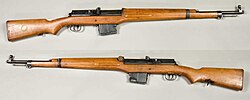 | 6.5×55mm |  Sweden Sweden | 1942 |
| AGM-1 carbine | AL.GI.MEC.Srl, Via Melzi d'Eril 21, I-20154 Milan | | 9x19 Parabellum |  Italy Italy | |
| AK-22 | Cugir Arms Factory | | .22 LR |  Romania Romania | |
| AMT Lightning 25/22 | Arcadia Machine & Tool | | .22 LR |  US US | 1984 |
| AR-57 | AR57 LLC |  | FN 5.7×28mm |  US US | 2008 |
| ARG S 40 | SAKO | | 5.56x45mm NATO |  Finland Finland | 2025 |
| Armaguerra Mod. 39 rifle | |  | 6.5×52mm Carcano 7.65×53mm Mauser |  Italy Italy | 1939 |
| Armalite AR-7 | Armalite | 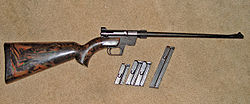 | .22 LR |  US US | 1959 |
| AR10T | Armalite |  | .308 Winchester
7.62×51mm NATO |  US US | 1956 |
| Armscor AK22 | Armscor | | .22 LR |  PHL PHL | 1987 |
| Armscor M16 22 | Armscor | | .22 LR |  PHL PHL | |
| Barrett 50 Cal/M82/M107 | Barrett Firearms Manufacturing |  | .50 BMG
.416 Barrett |  US US | 1989 |
| Barrett XM109 | Barrett Firearms Manufacturing |  | 25×59mm |  US US | 1990s |
| Barrett XM500 | Barrett Firearms Manufacturing | | .50 BMG |  US US | 2006 |
| BCL 102 | Black Creek Laboratories |  | .308 Winchester
7.62×51mm NATO
6.5mm Creedmoor |  Canada Canada | 2017 |
| Bear Creek Arsenal Huntmaster BC-8 | Bear Creek Arsenal | | .30-06 Springfield |  US US | 2024 |
| Benelli Argo | Benelli Armi SpA | | |  Italy Italy | |
| Benelli Argo Comfortech | Benelli Armi SpA | | |  Italy Italy | |
| Benelli Argo EL | Benelli Armi SpA | | |  Italy Italy | |
| Benelli MR1 | Benelli Armi SpA |  | 5.56 mm NATO
.223 Rem |  Italy Italy | 2005 |
| Beretta BM59 | Beretta |  | 7.62×51mm NATO |  Italy Italy | 1959 |
| Beretta Cx4 Storm | Beretta |  | 9×19mm Parabellum
9×21mm IMI
.40 S&W
.45 ACP |  Italy Italy | 2003 |
| Beretta Rx4 Storm | Benelli Armi for Beretta | | 5.56×45mm NATO
.223 Rem |  Italy Italy | 2005 |
| Berkut rifle | KBP Instrument Design Bureau | | .308 Winchester
7.62×54mmR
9×53mmR |  RUS RUS | 1998 |
| Big Horn Armory AR500 | Big Horn Armory | | .500 Auto Max |  US US | 2010s |
| Breda M1935 PG Rifle | Breda | | 6.5×52mm Mannlicher-Carcano
7×57mm Mauser |  Italy Italy | 1931 |
| Browning 22 Semi-Auto rifle | FN Herstal |  | .22 LR |  BEL BEL | 1914 |
| Browning BAR | Browning Arms Company | | |  BEL BEL | |
| Bushmaster Arm Pistol | Gwinn Firearms Company
Bushmaster Firearms International |  | 5.56×45mm NATO |  US US | 1972 |
Bushmaster M4gery
Bushmaster XM-15 | Bushmaster Firearms International |  | .223 Remington, 5.56x45 NATO (Bushmaster M4gery & XM15)
6.8mm Remington SPC, 7.62×39mm (Bushmaster M4gery) |  US US | 1990s |
| C6 [1] | Louis Chauchat & M Sutter at Puteaux Arsenal | | 7x59mm |  France France | 1907 |
| Calico Liberty | Calico Light Weapons Systems | | 9x19 Parabellum |  US US | 1980s |
| Calico M100 | Calico Light Weapons Systems |  | .22 LR |  US US | 1980s |
| Carbon 15 | Bushmaster Firearms International |  | 9×19mm Parabellum
.223 Remington
5.56×45mm NATO |  US US | 2006 |
| Cetme C | Cetme | | 7.62x51mm NATO |  Spain Spain | |
| Cetme L | Cetme | | 5.56×45mm NATO |  Spain Spain | |
| Charlton Automatic Rifle | Charlton Motor Workshops
Electrolux |  | .303 British |  New Zealand New Zealand | 1942 |
Colt AR-15
Semi Automatic AR15 Variants | Colt |  | .223 Remington
5.56×45mm NATO |  US US | 1960s |
| Diemaco C20 DMR | Colt Canada |  | 7.62x51mm NATO |  Canada Canada | 2020 |
| Daewoo DR-100 | Daewoo Precision Industries |  | 5.56×45mm NATO .223 Remington |  KOR KOR | 1987 |
| Crazy Horse rifle | Smith Enterprise Inc. | | 7.62×51mm NATO |  US US | 2003 |
| CZ 511 | Česká Zbrojovka Uherský Brod |  | .22 LR |  CZ CZ | |
| Demro TAC-1 | Demro | | .45 ACP |  US US | |
| Dragunov SVD | Kalashnikov Concern |  | 7.62×54mmR |  Soviet Union Soviet Union | 1963 |
| Dragunov SVU | KBP Instrument Design Bureau | 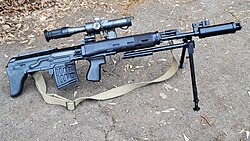 | 7.62×54mmR |  Russia Russia | 1994 |
| FEG Model 58 | Fegyver És Gépgyár | | 7.62×39mm |  Hungary Hungary | |
| FS2000 | FN Herstal |  | 5.56×45mm NATO |  BEL BEL | 1995 |
| FN FAL | FN Herstal |  | 7.62×51mm NATO |  BEL BEL | 1953 |
| FN FNAR | FN Herstal | | 7.62×51mm NATO |  BEL BEL | 2008 |
| FN Model 1949 | FN Herstal |  | .30-06 Springfield
7.92×57mm Mauser
7×57mm Mauser
7.62×51mm NATO
7.65×53mm Argentine |  BEL BEL | 1947 |
| PS90 | FN Herstal | | FN 5.7×28mm |  BEL BEL | |
| Farquhar–Hill rifle | | | .303 British |  UK UK | 1908 |
| Fort Ellis XR86 | Fort Ellis, Abingdon Pennsylvania | | 5.56×45mm NATO |  US US | 1986 |
| Frommer semiautotic rifle [2] | Rudolf Frommer | | | | |
| Fusil Automatique Modèle 1917 | Manufacture Nationale d'Armes de Tulle(MAT) for Mle 1917
Manufacture d'armes de Saint-Étienne(MAS) for Mle 1918. | 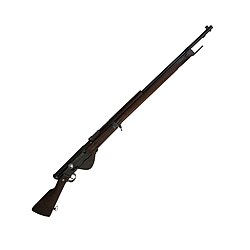 | 8×50mmR Lebel |  France France | 1917 |
| General Liu rifle | Hanyang Arsenal
Pratt & Whitney Machine Tool |  | 7.92×57mm Mauser |  Republic of China (1912–49) Republic of China (1912–49) | 1914 |
| German Sport Guns GSG-5 | German Sport Guns GmbH |  | .22 LR |  Germany Germany | 2007 |
| Gewehr 41 | |  | 7.92×57mm Mauser |  Nazi Germany Nazi Germany | 1941 |
| Gewehr 43 | |  | 7.92×57mm Mauser |  Nazi Germany Nazi Germany | 1943 |
| Hakim Rifle | Ministry of Military Production, Factory 54 |  | 7.92×57mm Mauser |  Egypt Egypt | 1950s |
| Harris Gun Works M-96 | Harris Gunworks | | 12.7×99mm NATO |  US US | |
| Heckler & Koch HK41 | Heckler & Koch |  | 7.62×51mm NATO |  West Germany West Germany | 1964 |
| Heckler & Koch HK43 | Heckler & Koch |  | 5.56mm NATO
.223 Remington |  West Germany West Germany | 1974 |
| Heckler & Koch PSG1 | Heckler & Koch |  | 7.62×51mm NATO |  West Germany West Germany | 1968 |
| Heckler & Koch SL6 | Heckler & Koch |  | 5.56mm NATO
.223 Remington |  Germany Germany | 1980s |
| Heckler & Koch SL7 | Heckler & Koch |  | 7.62x51 NATO
.308 Winchester |  Germany Germany | 1980s |
| Heckler & Koch SL8 | Heckler & Koch |  | .223 Remington
5.56×45mm NATO |  West Germany West Germany | 1998 |
| Heckler & Koch SLB 2000 | Heckler & Koch | | .308 Winchester |  Germany Germany | 2000 |
| Heckler & Koch SR9 | Heckler & Koch |  | 7.62×51mm NATO |  West Germany West Germany | 1990 |
| Hino Komuro M1904 | Hino Komuro | | 6.5×50mmSR Arisaka |  Japan Japan | 1904 |
| Hi-Point carbine | Hi-Point Firearms |  | 9×19mm Parabellum
.40 S&W
10mm Auto
.45 ACP
.380 ACP |  US US | 1990s |
| Howa Type 64 | Howa |  | 7.62×51mm NATO |  Japan Japan | 1964 |
| Howard Francis machine carbine | | | 7.63×25mm Mauser |  UK UK | |
| Howell Automatic Rifle | | | .303 British |  UK UK | 1915 |
| Itajubá Model 954 Mosquetão | IMBEL | | 7x57 Mauser |  Brazil Brazil | |
| Johnson Model 1936 | | | .30-06 Springfield |  United States United States | 1936 |
| KAL1 General Purpose Infantry Rifle | Small Arms Factory Lithgow | | 7.62×51mm NATO |  Australia Australia | 1970 |
| Kbsp wz. 1938M | |  | 7.92×57mm Mauser |  Poland Poland | 1934 |
| Kel-Tec RFB | Kel-Tec |  | 7.62×51mm NATO |  US US | 2003 |
| Kel-Tec SU-16 | Kel-Tec |  | 5.56×45mm NATO
.223 Remington |  US US | 2000s |
| Kel-Tec SUB-2000 | Kel-Tec | | 9×19mm Parabellum
.40 S&W |  US US | 2001 |
| Komodo Armament D7 PMR SA | PT Komodo Armament Indonesia | | 7.62×51mm NATO |  IDN IDN | 2014 |
| Krnka-Hirtenberg | | | 8×50mmR |  Austria-Hungary Austria-Hungary | 1908 |
| L1A1 Self-Loading Rifle | Royal Small Arms Factory |  | 7.62×51mm NATO |  UK UK | 1947 |
| M110 Semi-Automatic Sniper System | Knight's Armament Company |  | 7.62×51mm NATO |  US US | 2007 |
| M1903 Springfield primer actuacted prototype | | | .30-06 Springfield |  US US | 1921 |
| M1903 Springfield headspace operated prototype | | | .30-06 Springfield |  US US | |
| M1916 Kalashnikov automatic rifle | Sestroretsk plant | | 7.62x54mmR |  Russian Empire Russian Empire | 1916 |
| M1941 Johnson rifle | |  | .30-06 Springfield
7×57mm Mauser (Chilean variant)
.270 Winchester |  US US | 1941 |
| M1922 Bang rifle | |  | .30-06 Springfield
6.5×55mm Swedish |  United States United States | 1922 |
| M1947 Johnson auto carbine | | | .30-06 Springfield |  US US | 1947 |
| M1 carbine | | 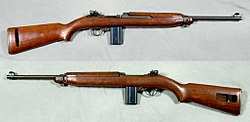 | .30 carbine |  US US | 1942 |
| M1 Garand | |  | .30-06 Springfield (7.62×63mm)
7.62×51mm NATO (.308 Winchester) (Postwar use by U.S.Navy) |  US US | 1934 |
| Sjögren rifle [3] | | | .30 Caliber |  Sweden Sweden | 1908 |
| Springfield Armory M1A | Springfield Armory |   | 7.62×51mm NATO (.308 Winchester), 6.5mm Creedmoor |  US US | 1954 |
| Stamm-Zeller 1902 [4] | Hans Stamm | | |  CH CH | 1902 |
| Standard Arms Model G [5] | Standard Arms | | .25 Remington
.30 Remington
.32 Remington
.35 Remington |  US US | 1909 |
| M21 Sniper Weapon System | Rock Island Arsenal
Springfield Armory |  | 7.62×51mm NATO |  US US | 1968 |
| M25 Sniper Weapon System | Springfield Armory |  | .308 Winchester |  US US | 1991 |
| M39 Enhanced Marksman Rifle | Sage International |  | 7.62×51mm NATO |  US US | 2008 |
| M89SR sniper rifle | Technical Consultants International | | 7.62×51mm NATO |  Israel Israel | 1980s |
| Madsen M1888 [6] | Dansk Rekyl Riffel Syndikat A/S | | 8×58mmR Danish Krag |  DNK DNK | 1888 |
| Madsen M1896 [7] [8] | Dansk Rekyl Riffel Syndikat A/S | | 8×58mmR Danish Krag .30-30 Winchester |  DNK DNK | 1896 |
| Marine Scout Sniper Rifle | Philippine Marine Corps |  | 5.56×45mm NATO |  PHL PHL | 1996 |
| Mannlicher M1893 self-loading rifle | Ferdinand Mannlicher | | 8x50mmR |  Austria-Hungary Austria-Hungary | 1893 |
| Mannlicher 1901/04 carbine [9] | Ferdinand Mannlicher | | 7.63×32mm Mannlicher |  Austria-Hungary Austria-Hungary | 1901 |
| Marlin Camp carbine | Marlin Firearms Company |  | .45 ACP
9×19mm Parabellum |  US US | 1985 |
| Marlin Model 60 | Marlin Firearms Company |  | .22 LR |  US US | 1960 |
| Marlin Model 70P | Marlin Firearms Company |  | .22 LR |  US US | |
| Marlin Model 795 | Marlin Firearms Company |  | .22 LR |  US US | |
| MAS-49 rifle | Manufacture d'armes de Saint-Étienne |  | 7.5×54mm French
.308 (Century Arms mass conversions) |  France France | 1949 |
| Meunier rifle | | | 7x59 "7mm Meunier" |  France France | 1900s |
| Mauser M1902 | Mauser | | |  German Empire German Empire | 1902 |
| Mauser M1913 Selbstladegewehr | Mauser | | 9mm caliber round, conjecture: 9x57mm |  German Empire German Empire | 1913 |
| Mauser M1916 | Mauser |  | 7.92×57mm Mauser |  German Empire German Empire | 1916 |
| MICOR Leader 50 | MICOR Defence | | .50 BMG |  US US | 2012 |
| Mk. 12 Special Purpose Rifle | |  | 5.56×45mm NATO |  US US | |
| Mk. 14 Enhanced Battle Rifle | Naval Surface Warfare Center Crane Smith Enterprise, Inc. Sage International | | 7.62×51mm NATO |  US US | 2001 |
| Mondragón rifle | Schweizerische Industrie Gesellschaft |  | 7×57mm Mauser
7.92×57mm Mauser
7.5×55mm Swiss |  Mexico Mexico | 1887 |
| Mossberg 702 Plinkster | O.F. Mossberg & Sons |  | .22 LR |  Brazil Brazil | 2003 |
| Mossberg 715T | O.F. Mossberg & Sons | | .22 LR |  US US | 2010 |
| MTB 1925 | | | 6.5×52mm Carcano |  Kingdom of Italy Kingdom of Italy | 1925 |
| Noreen BN30 | Noreen | | .30-06 Springfield |  US US | 2010s |
| Norinco JW-20 | Norinco | | .22 LR |  China China | |
| Norinco NHM 91 | Norinco | | 7.62×39mm |  China China | 1990s |
| Padovan 12.7mm | Jerko Padovan, Korcula | | .50 BMG |  Croatia Croatia | 1990s |
| Pauza P-50 | Pauza Specialties | | .50 BMG |  US US | 1991 |
| Pedersen rifle | |  | .276 Pederson |  US US | 1920s |
| Pindad SP-1 | PT Pindad (Persero) |  | 7.62×51mm NATO |  IDN IDN | 1970s |
| Pindad SS1-C | PT Pindad (Persero) |  | 5.56×45mm NATO |  IDN IDN | 1991 |
| Pindad SS3 | PT Pindad (Persero) |  | 7.62×51mm NATO |  IDN IDN | 2014 |
| Pindad SPM 1 | PT Pindad (Persero) |  | 5.56×45mm NATO |  IDN IDN | 2018 |
| Preetz Model 65 | | | .22 LR |  West Germany West Germany | 1965 |
| PSL (rifle) | Fabrica de Arme Cugir SA (ROMARM consortium) |  | 7.62×54mmR |  Romania Romania | 1974 |
| PTR 91F | Heckler & Koch, PTR Industries |  | 7.62×51mm NATO
.308 Winchester |  US US | 2000 |
| QBU-88 | Norinco |  | 5.8×42mm DBP87 (with non-standard loading)
5.56×45mm NATO (KBU-97A export variant) |  China China | 1997 |
| QBU-10 | Norinco |  | 12.7×108mm |  China China | 2010 |
| Rasheed carbine | Ministry of Military Production, Factory 54 |  | 7.62×39mm |  Egypt Egypt | 1950s |
| Remington Model Four | Remington Arms | | .243 Winchester
6mm Remington
.270 Winchester
.280 Remington
.30-06 Springfield
.308 Winchester |  US US | 1981 |
| Remington Model 8 | Remington Arms |  | .25 Remington
.30 Remington
.32 Remington
.35 Remington
.300 Savage |  US US | 1905 |
| Remington Model 24 | Remington Arms |  | .22 LR |  US US | 1922 |
| Remington Model 522 Viper | Remington Arms |  | .22 LR |  US US | 1993 |
| Remington Model 552 | Remington Arms | | .22 Short
.22 Long
.22 LR |  US US | 1957 |
| Remington Model 597 | Remington Arms |  | .22 LR
.22 WMR
.17 HMR |  US US | 1997 |
| Remington Model 740 | Remington Arms | | .244 Remington
.280 Remington
.308 Winchester
.30-06 Springfield |  US US | 1955 |
| Remington Model 742 | Remington Arms |  | .243 Winchester
6mm Remington
.280 Remington
.30-06 Springfield
.308 Winchester |  US US | 1960 |
| Remington Model 7400 | Remington Arms | | 6mm Remington
.243 Winchester
.270 Winchester
7mm Remington Express
.280 Remington
.30-06 Springfield
.308 Winchester
.35 Whelen |  US US | 1981 |
| Remington Nylon 66 | Remington Arms |  | .22 LR |  US US | 1959 |
| Remington Semi Automatic Sniper System | Remington Arms | | 7.62 NATO |  US US | 2010 |
| Rieder Automatic Rifle | | | .303 British |  South Africa South Africa | 1941 |
| Robinson Armament M96 Expeditionary | Robinson Armament Co. | | 5.56×45mm NATO |  US US | 1999 |
| Ruger 10/17 | Sturm, Ruger & Co. | | .17 HMR |  US US | 1964 |
| Ruger 10/22 | Sturm, Ruger & Co. |  | .22 LR
.22 Magnum |  US US | 1964 |
| Ruger Deerfield carbine | Sturm, Ruger & Co. |  | .44 Magnum |  US US | 2000 |
| Ruger Mini-14 | Sturm, Ruger & Co. |  | .223 Remington
5.56×45mm
.300 AAC Blackout |  US US | 1967 |
| Ruger Mini-30 | Sturm, Ruger & Co. |  | 7.62×39mm |  US US | 1987 |
| Ruger Model 44 | Sturm, Ruger & Co. |  | .44 Remington Magnum |  US US | 1960 |
| Ruger police carbine | Sturm, Ruger & Co. |  | 9×19mm Parabellum
.40 S&W |  US US | 1996 |
Ruger SR-556
Ruger AR-556 | Sturm, Ruger & Co. |   | 5.56×45mm NATO/.223 Remington
.300 AAC Blackout
6.8mm Remington SPC
.308 Winchester/7.62×51mm NATO (SR-762 only) |  US US | 2009 |
| Ruger XGI | Sturm, Ruger & Co. | | .308 Winchester
.243 Winchester |  US US | |
| Saiga semi-automatic rifle | Kalashnikov Concern |  | 7.62×39mm |  RUS RUS | 1990s |
| Kalashnikov SR-1 | Kalashnikov Concern |  | 5.56×45mm NATO .223 Remington |  RUS RUS | 2018 |
| Savage Model 64 | Savage Arms |  | .22 LR |  Canada Canada | |
| Selbstlader Model 06 | Georg Luger | | 7.92x57mm |  German Empire German Empire | 1906 |
| Scotti Mod. X | Società Anonima Armi Automatiche Scotti |  | 6.5×52mm Carcano |  Italy Italy | 1932 |
| Sheppard automatic rifle | U.S. Ordnance Co. | | .30-06 Springfield |  US US | 1914 |
| SIG MCX | SIG Sauer |  | 5.56×45mm NATO
.300 AAC Blackout
.277 Fury, 7.62x51mm
6.5 Creedmoor (MCX Spear) |  CH CH | 2010s |
| SIG Sauer SIGM400 | SIG Sauer |  | 5.56×45mm NATO
.223 Remington
.300 AAC Blackout |  Germany Germany | 2000s |
SIG Sauer SIG516
SIG716 | SIG Sauer |  | 5.56×45mm NATO
7.62x39mm (SIG516)
7.62×51mm NATO
6.5 Creedmoor (SIG716) |  Germany Germany | 2010 |
| SIG 522LR | SIG Sauer |  | .22 LR |  Germany Germany | 2009 |
| SIG550-1 | Swiss Arms AG | | 5.56x45mm NATO |  Switzerland Switzerland | 1988 |
| SIG 556 | SIG Sauer |  | 5.56x45mm NATO |  USA USA | |
| SIG750 | Swiss Arms AG | | 6.5mm Creedmoor |  Switzerland Switzerland | 2004 |
| Silver Shadow Gilboa Snake | Silver Shadow | | 5.56×45mm NATO |  Israel Israel | 2015 |
| SKS | |  | 7.62×39mm |  Soviet Union Soviet Union | 1945 |
| Smith & Wesson M&P10 | Smith & Wesson | | .308 Winchester
7.62×51mm NATO |  US US | 2013 |
| Smith & Wesson M&P15 | Smith & Wesson |  | 5.56×45mm NATO
.223 Remington |  US US | 2006 |
| Smith & Wesson M&P15-22 | Smith & Wesson |  | .22 LR |  US US | 2009 |
| Springfield 1903 Primer-Actuated Rifle | Springfield Armoury | | .30-06 Springfield |  US US | 1903 |
| Springfield Armoury SAR-8 Heavy Barrel Counter Sniper Rifle [10] | Springfield Armoury | | 7.62x51mm NATO |  US US | 1995 |
| Spuhr R-8000 ERS | Spuhr i Dalby AB | | 7.62x51mm NATO |  Sweden Sweden | 2019 |
| SR-25 | Knight's Armament Company |  | 7.62×51mm NATO |  US US | 1990 |
| Steyr M1911 [11] | Steyr | | 7×57mm Mauser |  Austria Austria | 1911 |
| Steyr-DMR 762 | Steyr Mannlicher | | 7.62x51mm NATO |  Austria Austria | 2023 |
| Steyr IWS 2000 | Steyr Mannlicher |  | 15.2x169mm |  Austria Austria | 1980s |
| STK SSW (firearm) | STK | | 5.7×28mm |  Singapore Singapore | |
| Sturmgewehr 58 | Fabrique Nationale de Herstal | 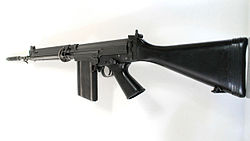 | 7.62×51mm NATO |  BEL BEL | 1958 |
| SVT-40 | |  | 7.62×54mmR |  Soviet Union Soviet Union | 1940 |
| T-62 Civilian Defense Rifle | Armalite | | .22 LR |  US US | 1962 |
| Tabuk Sniper Rifle | Al-Qadissiya Establishments |  | 7.62×39mm |  Iraq Iraq | 1970s |
| Terry carbine | Wilkinson Arms | | 9×19mm Parabellum |  US US | 1970 |
| Thompson Autorifle | Auto-Ordnance Company | 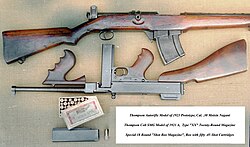 | .30-06 Springfield
7.62×54mmR (1923 model) |  US US | 1921 |
| Turner automatic rifle | Russel Turner | | .303 British |  US US | 1941 |
| Type Hei Rifle | Kokura Arsenal | | 6.5×50mmSR Arisaka |  Empire of Japan Empire of Japan | 1932 |
| Type Kō Rifle | Kokura Arsenal |  | 6.5×50mmSR Arisaka |  Empire of Japan Empire of Japan | 1933 |
| Type 4 rifle | Yokosuka Naval Arsenal |  | 7.7×58mm Arisaka |  Empire of Japan Empire of Japan | 1944 |
| United States Marine Corps Designated Marksman Rifle | |  | 7.62×51mm NATO |  US US | 2001 |
| Urutau | |  | 9x19 Parabellum |  Brazil Brazil | 2021 |
| Volkssturmgewehr | | 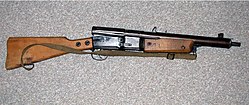 | 7.92×33mm Kurz |  Nazi Germany Nazi Germany | 1944 |
| Vulcan V18 | | | 5.56×45mm NATO |  US US | 1991 |
| Vz. 52 rifle | Považské strojárne
Česká zbrojovka |  | 7.62×45mm (vz. 52)
7.62×39mm (vz. 52/57) |  CZ CZ | 1952 |
| Walther G22 | Walther |  | .22 LR |  Germany Germany | |
| Walther WA 2000 | Walther | | 7.62×51mm NATO
.300 Winchester Magnum
7.5×55mm Swiss |  West Germany West Germany | 1982 |
| Winchester Model 1903 | Winchester Repeating Arms Company |  | .22 Winchester Automatic |  US US | 1903 |
| Winchester Model 1905 | Winchester Repeating Arms Company |  | .32 Winchester Self-Loading
.35 Winchester Self-Loading |  US US | 1905 |
| Winchester Model 1907 | Winchester Repeating Arms Company |  | .351 Winchester Self-Loading |  US US | 1907 |
| Winchester Model 1910 | Winchester Repeating Arms Company |  | .401 Winchester Self-Loading |  US US | 1910 |
| Winchester model 30 | Winchester Repeating Arms Company | | .30-06 Springfield |  US US | 1939 |
| Xiangying rifle | Jin-Sui District Arsenal No.2 | | 6.5x50mm Arisaka |  Republic of China (1912–49) Republic of China (1912–49) | 1944 |
| Zastava M76 | Zastava Arms |  | 7.92×57mm Mauser |  Yugoslavia Yugoslavia | 1976 |
| Zastava M91 | Zastava Arms |  | 7.62×54mmR |  Yugoslavia Yugoslavia | 1991 |
| ZH-29 | Ceskoslovenska Zbrojovka |  | 7.92×57mm Mauser |  CZ CZ | 1929 |
| Zijiang M99 | Zinjiang Machinery Company | | 12.7×108mm |  China China | 2005 |
|













































































































